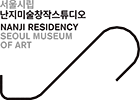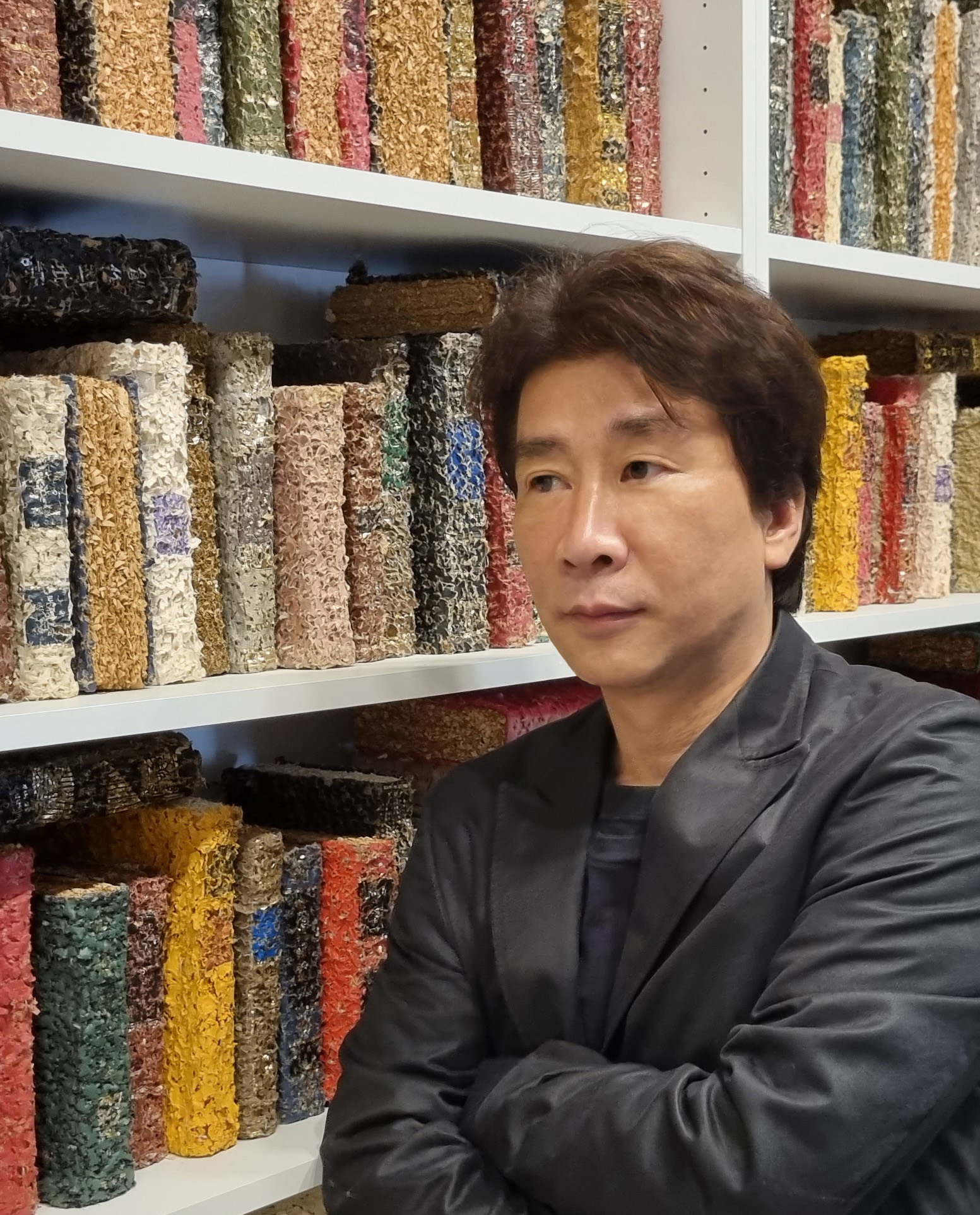
Artist Dohee Yoo’s work mainly consists of black-and-white photographs that include ‘a strange black object.’ The object is ‘an abandoned rubber plate’ that she found by chance at an abandoned coal factory. A rubber plate with traces of time like scratches in its thick and black skin is a useless thing, dirty and shabby. The artist engages with this object by photographing it — an object that was once abandoned by ‘someone’ and became useless, rendered useful through the artist Dohee Yoo’s photographic work. An accidental discovery and a spontaneous choice turn a shabby rubber plate into a longtime companion in her own art world.
A Strange Object — A Transformation of Something Shabby
A blackish rubber plate full of wounds! What of this shabby thing captivated her? What kind of empathy originated from this object? About her work she says, “In my work, like an oriental painting I express an object in an abstract form like a bold stroke in the realistic natural landscape and background, using a camera instead of a brush on the canvas of photographic paper and black and white instead of ink stick, thereby trying to find harmony and meaning in it.”
As one can infer from her artist’s note, Yoo definitely seems to have got the idea of calligraphic abstraction drawn with a stroke of a brush from a big rubber plate discarded in the landscape. The calligraphic abstraction of a stroke of a brush that makes a big stride and then stops indifferently without hesitation! The original author of the ‘calligraphic abstraction of a stroke in the landscape’ is ‘someone’ who threw away the rubber plate, but it is the artist who brings it to the world of art in the name of photography. The experience of an intense visual perception of a moment creates memories that lead her work and has leads the flow of time.

Lost road, 2014, Rubber, C-Print, 78x120cm, ed1/3
Image provided by artist
Courtesy of the artist

Untitled(at Yeonchen), 2017, Rubber, C-Print, 100x83cm, ed1/3
Image provided by artist
Courtesy of the artist
However, Yoo’s black rubber plate has something strange to it; it has a broad and varied amplitude of transformation that fluctuates between this and that, confronting each other in its ‘flexibility’ and ‘stiffness.’ As is seen in her work it looks pathetic like the body of someone with no family and friends rolled up with a straw mat on a desolate plain; or it is as lively as a fresh fish jumping up out of the water. Sometimes it seems as withdrawn as a monk walking on the street or as insidious as a soldier in an ambush, trying to hide his body in the woods at times. That is not all. There are times where masochism, passivity and halt exist and where sadism, activity and movement are waving on the rubber plate.

Untitled(at Seolleung), 2013, Rubber, C-Print, 77.3x116cm, ed1/3
Image provided by artist
Courtesy of the artist
Unpredictable and infinite transformation! The potentiality of this transformation and change exists everywhere in Yoo’s work. Let’s think about it. As in the minimalist artist Robert Morris’ felt work, Yoo’s wide rubber plate composed of ‘two-dimensional rectangular planes’ transforms into ‘a three-dimensional sculpture’, while being stacked or rolled up. When it is erected between the trees or lying on the beach, it changes into ‘an installation work’.

Untitled(at Seolleung), 2013, Rubber, C-Print, 77.3x116cm, ed1/3
Image provided by artist
Courtesy of the artist
No! Rather, it deserves to be called ‘Nature Art’ or ‘Land Art’, as it embraces the spaces of nature. It is also the ‘art of process’ as well as the ‘art of time’ in which both the ‘artist,’ the subject of creation, and the ‘rubber plate,’ the tool and object of creation, embrace the flow of constantly changing natural environments with their whole bodies. The act of placing the heavy rubber plate in the landscape and land while carrying it from place to place itself is a ‘performance’ accompanied by hard labor. A series of such ‘performing arts’ can be named as ‘photographic act projects’ in a way because she planned and directed them for her photography.
‘The object in the landscape’ reproduced in black and white on the photographic paper is a simulacre that captures and fixates the moment of reality in space and time. But it soon changes from image to imagery as it is associated with an oriental painting or calligraphy, as if the dark ink swept the traditional Korean paper using a drybrush technique. It can be described as the ‘profound mind-scape,’ namely the ‘landscape of in-depth imagery,’ which captures the ‘landscape made’ through the ‘found object’ captured in the camera angles.

Exhibition view of Landscape, 2014, The K Gallery
Image provided by artist
Courtesy of the artist
The Portrait of a Strange Object — Inside and Outside Photography
Is photography then the final form of Yoo’s work? Her photographs are complete and positioned as images inside a frame — but in a way it is not the final form. Photo cuts gathered together turn into a video; photos printed on the photographic paper also imply another direction as a ‘naked photo without a frame’ while being rolled up from the bottom and hung on the wall with a pin. It seems paradoxical that while Support-Surface, a French group in the 1970s installed and exhibited works without frames in the process of examining the essence of ‘pure art’ and painting structures to be shown to viewers, Yoo’s method of installation is manifested in a continuous circulation of numerous transformations to be photographs. In other words, the process of transformation and the encounter with its opposites, such as three-dimensional - two - dimensional, sculpture - plane - installation, nature art - land art - process art, abandoned - discovered, halt - move and reality - simulacre, do not end even when reaching the its form of ‘constructed photography printed on paper’.
The printed photos meet the actual net or rubber plate again in the ‘name of an exhibition,’ and is recorded as a ‘photograph called an archive’ for catalogues and portfolios. To put it differently, a black rubber plate repeats its transformation infinitely by meeting ‘photographs’ and ‘things that are not photographs’ in a varied way. In this manner the infinite transformation of a ‘strange object’ in an encounter of environments seems to be endless. This is why the title ‘The Portrait of a Strange Object’ is what it is.
Yoo mentions in her artist’s note, “I am planning to express many transformations in life using more diverse forms of media and methods from now on.” When she says “diverse media and methods,” she appears to express her will of creating and to not stick to the medium of photography only. This is connected with forms of media that transcend the ‘boundaries of photography’ and their artistic uses. Besides, thoughts and feelings of the post-pandemic era and the Anthropocene in relation to Covid-19 circumstances serve as inspiration to create a new work. In any case it is the role of the artist to devise and change these various mediums and methods. It is difficult for me to theorize how her work will change. As a matter of fact, it is completely up to Dohee Yoo who is in charge of its creation.
The important point remaining is as follows: one may doubt if the artist recognized this rubber plate, a tool as well as an object of creation, merely as an ‘image,’ because the visual experience of this ‘abandoned black rubber plate’ that she had encountered was too strong. The extreme interest in the work — seeing it as something with vivid energy, like the stroke of a brush on the canvas of an oriental painting or as the body that is implicit and apocalyptic — appear to be based on intense memories mostly coming from visual experience. Yoo makes active use of the elasticity of rubber by rolling up the rubber plate or tying it up and placing it in the landscape. But what leaves something to be desired is the lack of diverse formal experimentation on the properties of rubber. The elasticity of rubber that the artist also recognizes is a scientific and physical phenomenon. In this regard it is probably necessary to develop formal experiments on the rubber plate, which is the tool and object of creation, into an experiment on ‘rubber’s own property’ like its elasticity, escaping from the shell of an image in a more in-depth manner. A scientific approach of examining and exploring the elasticity and tension of the rubber plate may be needed. Then, a new grammar of analyzing the ‘object of rubber plate’ from the methodology of science and physics by moving a bit from the limitations of the formal language of ‘the rubber plate in the artist’s visual-perceptual experience’ encountered as a shock, or that of pursuing social metaphors may be found. In other words, it is not impossible to attempt a new direction for work from a different dimension, if research on diverse changes in properties of rubber, depending on the temperature, pressure, atmosphere and humidity is combined. I expect that Yoo’s ‘Portrait of an Object,’ a rubber plate manipulated inside and outside photography, will expand into its ‘profound strangeness.’
※ This content was first published in 『2021 SeMA Nanji Residency Program Catalogue』, and re-published here with the consent of SeMA Nanji Residency.

Sung-Ho KIM
He is a graduate of the Department of Theology at Presbyterian University and Theological Seminary, Department of Western Painting at Chung-Ang University, the Department of Culture and Arts at Chung-Ang Graduate School and DEA in Philosophy at University Paris X. He holds a Ph.D in Aesthetics & Science of Art at University Paris I, France, majoring in Aesthetics. He has worked as a Curator of Moran Art Museum, Chief editor of Misulsegae monthly art magazine, Expert member of Seongnam Cultural Foundation, Director of KunstDoc Art institute, Adjunct professor at Chung-Ang University, Artistic Director of the Geumgang Nature Art Biennale 2014, Artistic Director of the Sea Art Festival 2015, Artistic Director of Suncheon bay international eco-environmental art festival 2016 and Artistic Director of Special Exhibition of Korea, Dakar Biennale 2014. He finished post-doctor at UNIST and has published five books including A Critical Biography of the Curator Wonil Rhee (2015).He is currently Artistic Director of Changwon Sculpture Biennale 2020, Director of Yeoju Art Museum and an Art Critic in Korea.


